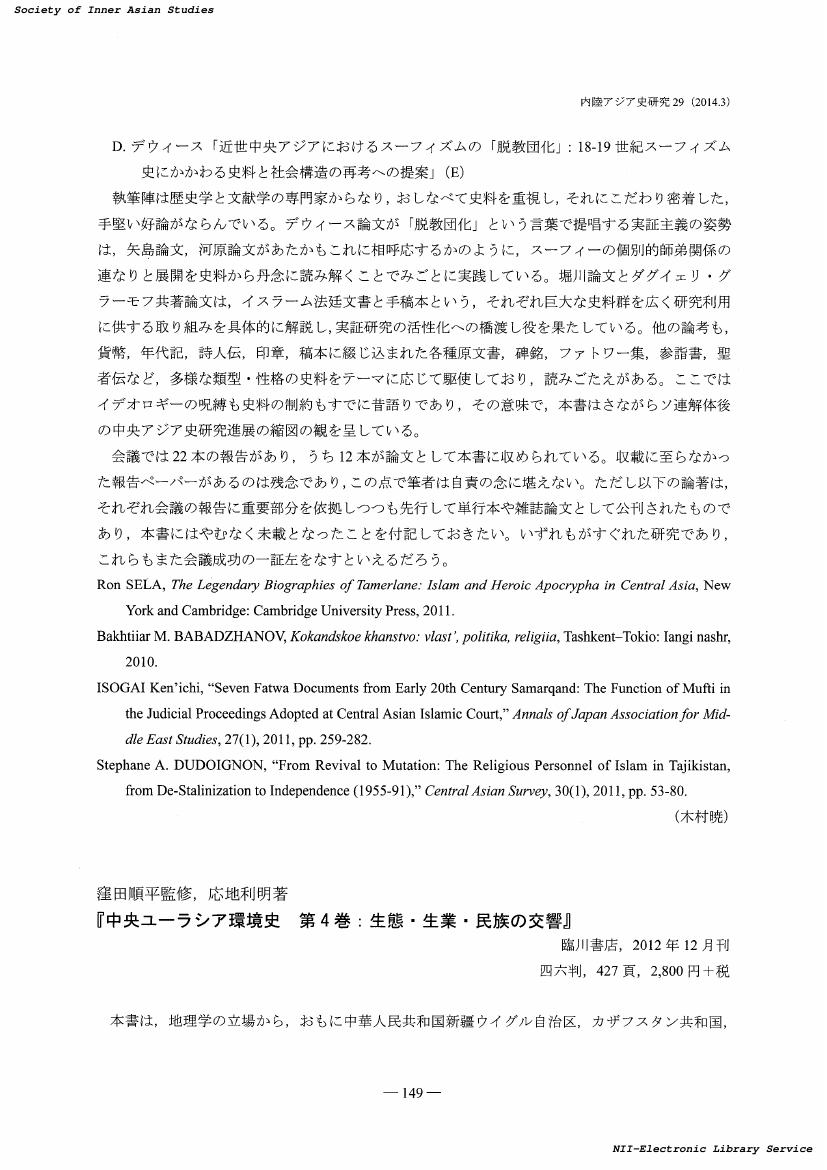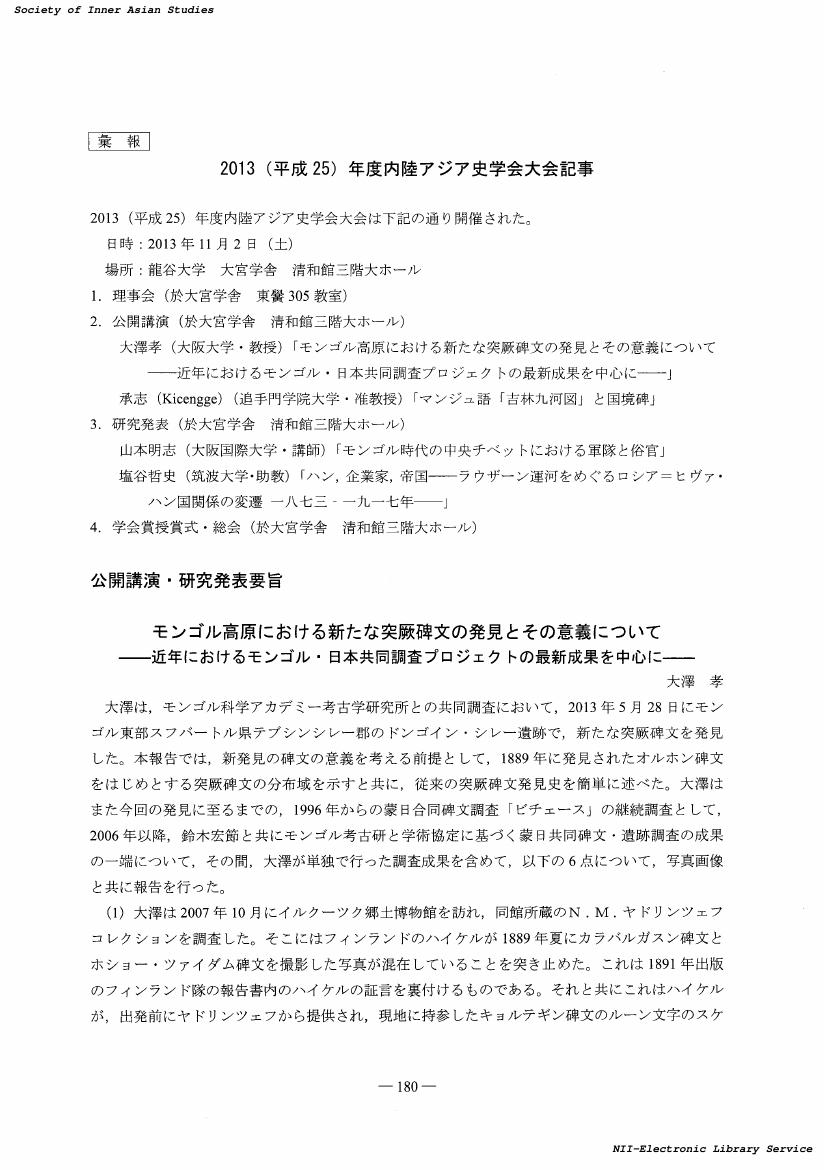- 著者
- 木村 暁
- 出版者
- 内陸アジア史学会
- 雑誌
- 内陸アジア史研究 (ISSN:09118993)
- 巻号頁・発行日
- vol.29, pp.148-149, 2014-03-31 (Released:2017-10-10)
- 著者
- 塩谷 哲史
- 出版者
- 内陸アジア史学会
- 雑誌
- 内陸アジア史研究 (ISSN:09118993)
- 巻号頁・発行日
- vol.29, pp.149-150, 2014-03-31 (Released:2017-10-10)
- 著者
- 橘 誠
- 出版者
- 内陸アジア史学会
- 雑誌
- 内陸アジア史研究 (ISSN:09118993)
- 巻号頁・発行日
- vol.29, pp.151-152, 2014-03-31 (Released:2017-10-10)
- 著者
- 川口 琢司
- 出版者
- 内陸アジア史学会
- 雑誌
- 内陸アジア史研究 (ISSN:09118993)
- 巻号頁・発行日
- vol.29, pp.152-153, 2014-03-31 (Released:2017-10-10)
- 著者
- 山下 将司
- 出版者
- 内陸アジア史学会
- 雑誌
- 内陸アジア史研究 (ISSN:09118993)
- 巻号頁・発行日
- vol.29, pp.153-154, 2014-03-31 (Released:2017-10-10)
1 0 0 0 OA アブデュルレシト・イブラヒム著, 小松香織・小松久男訳, 『イスラーム原典叢書 ジャポンヤ-イブラヒムの明治日本探訪記』, 岩波書店, 2013年7月刊, A5判, 540頁, 9,400円+税
- 著者
- 河原 弥生
- 出版者
- 内陸アジア史学会
- 雑誌
- 内陸アジア史研究 (ISSN:09118993)
- 巻号頁・発行日
- vol.29, pp.154-155, 2014-03-31 (Released:2017-10-10)
- 著者
- 野田 仁
- 出版者
- 内陸アジア史学会
- 雑誌
- 内陸アジア史研究 (ISSN:09118993)
- 巻号頁・発行日
- vol.29, pp.155-157, 2014-03-31 (Released:2017-10-10)
- 著者
- 塩谷 哲史
- 出版者
- 内陸アジア史学会
- 雑誌
- 内陸アジア史研究 (ISSN:09118993)
- 巻号頁・発行日
- vol.29, pp.157-158, 2014-03-31 (Released:2017-10-10)
- 著者
- 小林 亮介
- 出版者
- 内陸アジア史学会
- 雑誌
- 内陸アジア史研究 (ISSN:09118993)
- 巻号頁・発行日
- vol.29, pp.158-159, 2014-03-31 (Released:2017-10-10)
- 著者
- 大澤 孝
- 出版者
- 内陸アジア史学会
- 雑誌
- 内陸アジア史研究 (ISSN:09118993)
- 巻号頁・発行日
- vol.29, pp.180-181, 2014-03-31 (Released:2017-10-10)
1 0 0 0 OA 編集後記
- 出版者
- 内陸アジア史学会
- 雑誌
- 内陸アジア史研究 (ISSN:09118993)
- 巻号頁・発行日
- vol.28, pp.App1, 2013-03-31 (Released:2017-10-10)
1 0 0 0 OA 武則天期「鉄勒四部の南徙」再考 : 『新唐書』の基礎的分析を通じて
- 著者
- 西田 祐子
- 出版者
- 内陸アジア史学会
- 雑誌
- 内陸アジア史研究 (ISSN:09118993)
- 巻号頁・発行日
- vol.29, pp.1-16, 2014-03-31 (Released:2017-10-10)
This article reviews "the migration of the four Tiele tribes (Uighur 回鶻, Qibi 契〓, Sijie 思結, and Hun 渾)" in the Wuzutian era. It is conventional wisdom that these nomads moved into the Hexi 河西 region together at the same time. This "migration" theory has been speculated upon based on the writings of Xin-Tangshu, Jiu-Tangshu 『旧唐書』, and Tang-huiyao 『唐会要』. In the previous article, the author already pointed out that the Xin-Tangshu Uighur Account 回鶻伝 cannot be used as a basis for historical consideration, and it is necessary to eliminate the biased context that has been introduced by Xin-Tangshu editors. Based on such conclusion, the author maintains that the "migration" context in Xin-Tangshu was obviously borrowed by the editors from previous accounts and cannot be supported by extant historical sources. The conclusion of this article helps us to avoid considering all Turkic nomads living in the Hexi region as a single group and individually analyzes the ways in which each population group interacted with the Tang Dynasty.
1 0 0 0 OA フレグのウルスと西征軍
- 著者
- 高木 小苗
- 出版者
- 内陸アジア史学会
- 雑誌
- 内陸アジア史研究 (ISSN:09118993)
- 巻号頁・発行日
- vol.29, pp.17-41, 2014-03-31 (Released:2017-10-10)
This paper analyses the formation of the Ilkhanate from the standpoint of the composition and attribution of troops under the command of the first Ilkhan, Hulegu. In 1206, Chinggis Khan organized troops under his command into groups of 1,000 men. He distributed some of these groups among his younger brothers and sons as qubi. Each recipient formed his own ulus, or khanate. In 1254, Mongke Qa'an, a grandson of Chinggis Khan, dispatched his younger brother Hulegu to conquer West Asia. According to Jami' al-Tawarikh, which was compiled in the early 14th century, Mongke, having consulted with members of his family, ordered that henceforth the two tama groups that had been garrisoned in West Asia during the late 1220s should be transferred to the command of Hulegu. In addition, Mongke resolved that the troops conscripted from among the groups of 1,000 men were to be granted to Hulegu as his inju. After Mongke's death, his other brother, Qubilai, acceded to the throne of Qa'an in 1260 and recognized Hulegu's reign over 'the Mongol troops and the regions of Tazik, or Iran Zamin'. This paper demonstrates that these troops were not transferred to Hulegu during the reign of Mongke Qa'an. The later writings of Jami' al-Tawarikh justify both the rule of Hulegu and his descendants over these troops and Iran Zamin, in particular that of Hulegu's great grandson, Ghazan Khan, and also the formation of the Ilkhanate. In reality, these troops came under the command of Hulegu and his descendants in stages between the second half of Hulegu's reign and the first half of the reign of his successor, Abaqa Khan. Moreover, this paper illustrates that Ilugei Noyan from the Jalair tribe and Sunjaq Noyan from the Suldus tribe belonged to Hulegu's primary ulus formed in Mongolia before 1238. Thus, their families and descendants maintained their power and influence over Iran Zamin even after the decline of the Ilkhanate in the late 1330s.
1 0 0 0 OA 清代前期における人参採取制度と内務府商人
- 著者
- 孫 暁瑩
- 出版者
- 内陸アジア史学会
- 雑誌
- 内陸アジア史研究 (ISSN:09118993)
- 巻号頁・発行日
- vol.29, pp.43-64, 2014-03-31 (Released:2017-10-10)
This article studies changes in government policy on ginseng business from the late Kangxi to the early Qianlong period, by examining the role of merchants of the Imperial Household Department (nei-wu fu) in ginseng gathering from 1714 to 1744. In the late years of Kangxi, nei-wu fu's merchants directly purchased all ginseng permits from the government and resold them to local businessmen. Due to overstocking and the numerous defects of this system, the government abandoned ginseng permits in the first year of Yongzheng's reign, and directly hired ginseng diggers. The government restarted the issuing of ginseng permits in the eighth year of Yongzheng's reign; nei-wu fu's merchants were in charge of distributing the permits with flexible quotas. However, with decreasing ginseng supply and because of the responsibility of paying for losses in case diggers fled, nei-wu fu's merchants deliberately limited the total number of ginseng permits issued each year. To deal with this, the Qing government applied a fixed ginseng permits system that required nei-wu fu's merchants to issue a fixed number of permits and pay for any losses. This system led to huge fiscal deficits for the nei-wu fu's merchants and consequent termination of this new business model. Afterwards, the government took over the distribution of ginseng permits with local liquor store owners in the northeast serving as diggers' sponsors.
1 0 0 0 OA 『ハルハ=ジロム』における乾隆11年法の再検討 : 蒙古例の乾隆12年法を手がかりとして
- 著者
- 蒙古勒呼
- 出版者
- 内陸アジア史学会
- 雑誌
- 内陸アジア史研究 (ISSN:09118993)
- 巻号頁・発行日
- vol.29, pp.65-84, 2014-03-31 (Released:2017-10-10)
During the course of the Qing-Junggar war, the Qing Empire strengthened its control over Qalqa from the 1720s to the 1730s. In an effort to deter theft and robbery, the Qing government actively applied the code of "Mongyul cayaja-yin bicig" to Qalqa and adopted a flexible legal policy that combined the old article of 1674 with the new one that was enacted in 1727. Under these circumstances, the Qalqa's nobles drew up the 1746 law that dealt with the problems of crime compensation and the escorting of criminals. The 1746 law was mainly based on the old article of "Mongyul cayaja-yin bicig" and supplemented with the Qalqa's original compensation practices. Next, the Qing government accepted Boode's proposition to reflect the attitudes of the Qalqa's nobles embodied in the 1746 law and legislated against stealing livestock in 1747. This law of 1747 comprised the old and new articles, established respectively in 1667 and 1727, and provisions of the Qalqa's original crime compensation law. This reveals that not only the code of the Qing Empire penetrated the Qalqa, but the attitudes and expectations of the Qalqa's nobles also had some influence on the enactment of the Qing's law. Finally, the 1746 law is not the "vice-generals' law". The latter was probably enacted from 1728 to 1738 and applied to the cases of stealing stock in the Qianlong period.
1 0 0 0 OA 清代外モンゴルにおける牧地紛争の発生形態 : 中部二盟の諸事例を中心に
- 著者
- チョウルモングリル(朝魯孟格日勒)
- 出版者
- 内陸アジア史学会
- 雑誌
- 内陸アジア史研究 (ISSN:09118993)
- 巻号頁・発行日
- vol.29, pp.85-110, 2014-03-31 (Released:2017-10-10)
This paper examines outbreak patterns and punishments in pasture conflicts from the end of the Qianlong 乾隆 period to the 19-th century, based on historical documents preserved in the National Central Archives of Mongolia. The study reveals two types of outbreak patterns. The first one is a typical pattern that consists of the following four stages: (1) Nomads from the outside invade the pasture. (2) Local nomads seize the livestock of the intruders as collateral. (3) The intruders leave the pasture. (4) The local nomads return the livestock. The other pattern relates to breaking the Obo that was built against the will of the local nomads. For the former pattern (the typical one), in the case of a conflict among commoners, no punishments were levied, whereas in the case of a conflict between commoners and Yekesabi, the commoners were lightly punished according to the precedents. In the latter pattern (destroying the Obo), those who destroyed the Obo were punished as a light crime, according to the konggen cayajan-u bicig.
- 著者
- 河野 敦史
- 出版者
- 内陸アジア史学会
- 雑誌
- 内陸アジア史研究 (ISSN:09118993)
- 巻号頁・発行日
- vol.29, pp.111-133, 2014-03-31 (Released:2017-10-10)
In its administration of Huibu, present south Xinjiang, the Qing adopted the Beg system, which involved appointment of an influential Turkic Muslim as a bureaucrat to carry out indirect rule. The Kashgar Khwaja family, descendants of Makhdum-i A'zam, launched repeated campaigns into Huibu from the 1820s to the 1850s in order to recover the territory that had formerly been theirs. This article examines the defense organized by the Begs in Kashgar against the campaign of "the Seven Khwajas." The study shows that with the support of Qing troops under the command of Zuhur al-Din, the Hakim Beg at Kashgar, the Begs led by the Turfan junwang family took countermeasures against the Khwaja family, which had a strong influence on this area. This was done by mobilizing Turkic Muslim troops, the Begs' own military power, and gaining the cooperation of the Akhunds, an anti-Khwaja family. However, the Begs failed in their defense. Their actions were limited. The author argues that the defensive action of the Begs played only a secondary role in the broader defensive strategy of the Qing.
- 著者
- 諫早 庸一
- 出版者
- 内陸アジア史学会
- 雑誌
- 内陸アジア史研究 (ISSN:09118993)
- 巻号頁・発行日
- vol.29, pp.135-145, 2014-03-31 (Released:2017-10-10)
- 著者
- 秋山 徹
- 出版者
- 内陸アジア史学会
- 雑誌
- 内陸アジア史研究 (ISSN:09118993)
- 巻号頁・発行日
- vol.29, pp.147, 2014-03-31 (Released:2017-10-10)
- 著者
- 秋山 徹
- 出版者
- 内陸アジア史学会
- 雑誌
- 内陸アジア史研究 (ISSN:09118993)
- 巻号頁・発行日
- vol.28, pp.166-167, 2013-03-31 (Released:2017-10-10)













